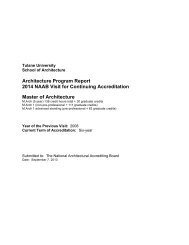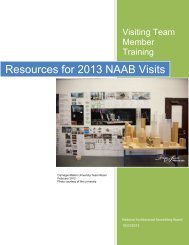Architecture Program Report Tulane University New Orleans ...
Architecture Program Report Tulane University New Orleans ...
Architecture Program Report Tulane University New Orleans ...
You also want an ePaper? Increase the reach of your titles
YUMPU automatically turns print PDFs into web optimized ePapers that Google loves.
● Outreach efforts of centers and institutes such as the Levy Rosenblum<br />
Institute for Entrepreneurship, the federally-funded outreach program of the Stone<br />
Center for Latin American Studies and the "For the Children" program<br />
● Joint efforts in community service by the <strong>Tulane</strong>/Loyola<br />
The School of <strong>Architecture</strong> Strategic Plan seeks to reinforce this 'call to service' by<br />
amplifying the presence of the School in the area of Service Learning, and by also<br />
developing the <strong>Tulane</strong> City Center. This new 'institution' will propel the School to the<br />
forefront of this rich, if heretofore unimagined, opportunity.<br />
In addition, the School of <strong>Architecture</strong> will reinforce its strategy for learning based on the<br />
tradition of a 'core curriculum'—a tradition that has been acknowledged by not only our<br />
National Accreditation Board, but by the discipline and profession itself.<br />
Moreover, the School maintains a longstanding focus on academic advising in two ways:<br />
through low student/faculty ratios and through an institutionalized advising program.<br />
The unique partnership between <strong>Tulane</strong>, Dillard and Xavier Universities (two HBCUs)<br />
will provide new opportunities for the profession and the discipline to establish a core<br />
commitment to diversity—a component of the Carnegie Foundation for the Arts study<br />
"Building Community" [see pp. ( )].<br />
______________________________________________________________________<br />
Still other conditions impact questions surrounding contemporary architectural practice<br />
and education.<br />
A. Architectural Practice<br />
1. Economic and Market Forces<br />
According to the Federal Reserve's Brown Book, within the past year most regions of the<br />
United States have enjoyed strong economic growth in the private and public sectors.<br />
This has resulted in a fairly stable construction market. Thus, the demand for not only<br />
licensed architects, but architects who have completed their education (internarchitects),<br />
is at an all-time high. Skilled architects are part of the overall picture of<br />
economic health, with their ability to design not only buildings (the construction market),<br />
but aspects of the consumer market as well. However, the economic cycles of both<br />
aspects of the market can be volatile, as more recent history has indicated.<br />
The practice of architecture for today's professionals—only yesterday's students—is not<br />
limited to the United States, but is increasingly a global enterprise as well. While it is<br />
true that US-trained architects dominate in the corporate design sector, this is now<br />
challenged by foreign trained architects who excel at both digital media technologies and<br />
historical engagement in the civic arena. Nonetheless, the expanding global market has<br />
increased opportunities for architects educated in the United States, and practice is now<br />
enabled worldwide (despite one's location) through the use of modern computer<br />
technologies.<br />
While the corporate design sector maintains the predominant share of available<br />
employment opportunities for architects, several areas of architectural practice have<br />
been expanding, including service-based public and private management, environmental<br />
technology and sustainability, historic preservation, new construction and material














